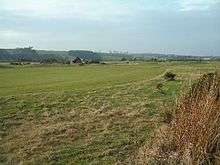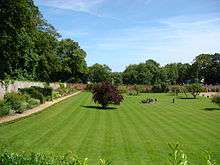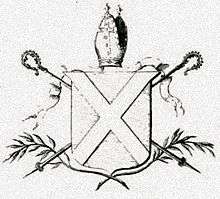Strathtyrum

Strathtyrum (from "strath" and tioram, meaning "dry valley")[1][2] is a 400-acre (160 ha) country estate in the north-western outskirts of St Andrews, Fife, Scotland. It is accessed via the A91.[3][4]
History


The estate was owned by St Andrews Cathedral Priory prior to the Reformation, whereafter ownership was granted to the Duke of Lennox and it subsequently changed hands several times.[5][6] It was purchased by Archbishop James Sharp in 1669 and by James Cheape, the son of a laird, in 1782.[5][6][7]
The adjacent property of St Andrews Links on the northern side of the estate was acquired by James Cheape in 1821 and sold by his brother's grandson, also named James Cheape, to The Royal and Ancient Golf Club of St Andrews in 1893.[8][9][10] Control of St Andrews Links was regulated by an act of Parliament in 1894 and another in 1974 which resulted in the creation of the St Andrews Links Trust.[11] The Strathtyrum Course of St Andrews Links, which was opened in 1993, was built on land that was previously part of the estate and sold to the St Andrews Links Trust by Mrs Gladys Cheape in 1986.[3][8] The Strathtyrum estate was subsequently inherited by Henry Cheape.[4][12]
Buildings
There are several buildings on the estate including the main residential building Strathtyrum House located opposite the Old Course at St Andrews, a Category A listed building built in the 18th century.[13][14] It is a Georgian building three storeys high accompanied by riding stables, a mausoleum and a large walled garden.[4][6][15] It was the rented country residence of publisher John Blackwood who died there in 1879.[3][16][17]
While attending the University of St Andrews where they met, Prince William and his future wife Catherine Middleton lived in Balgove House on the estate for two years before graduating in 2005.[4][18]
See also
- List of Category A listed buildings in Fife
- List of listed buildings in St Andrews And St Leonards, Fife
References
- ↑ Liddall, William John Norbray (1896). The Place Names of Fife and Kinross. Edinburgh: W Green & Sons. p. 54. Retrieved 20 January 2016.
Strathtyrum. Strath + tioram = the dry strath.
- ↑ "The Kingdom of Fife". Edinburgh Review, 1896: Or Critical Journal (Reprint ed.). London: Forgotten Books. 2013. p. 419. Retrieved 26 January 2016.
Strathtyrum, near the links of St. Andrews, once the property of Archbishop Sharp, is Strathtioram, 'the dry valley'.
- 1 2 3 Glen, Duncan (1998). Illustrious Fife: Literary, Historical & Architectural Pathways & Walks. Kirkcaldy, Scotland: Akros. p. 14. ISBN 9780861420872. Retrieved 17 January 2016.
- 1 2 3 4 "Prince William's university residence rented for Golf competition". Sunday Express. 4 July 2010. Archived from the original on 17 January 2016. Retrieved 17 January 2016.
- 1 2 Leighton, John M; Stewart, James (1840). History of the County of Fife: From the Earliest Period to the Present Time, Volume 3. Glasgow: Joseph Swan. p. 42. Retrieved 17 January 2016.
- 1 2 3 Lamont-Brown, Raymond (2006). St Andrews: City by the Northern Sea. Edinburgh: Birlinn. p. 116. ISBN 9781841584508. Retrieved 18 January 2016.
After the Reformation, Strathtyrum estate was resumed by the Crown and conferred on the family of the Duke of Lennox. By 1596 the estate passed to James Wood of Lambieletham and was later assumed by the Inglises who sold it to Archbishop James Sharp in 1669; Sharp's dwelling has long vanished. Soon after this the estate was subdivided and in 1782 Strathtyrum was acquired by James Cheape.
- ↑ Stephen, Thomas (1839). The Life and Times of Archbishop Sharp. London: Joseph Rickerby. p. 631. Retrieved 17 January 2016.
- 1 2 Hagen, John Peter (2011). Play Away Please: The Tale of the Sale of Golf's Greatest Icon – The St Andrews Old Course Starter's Box. Random House. ISBN 9781907195754. Retrieved 17 January 2016.
- ↑ Malcolm, David (2011). Tom Morris of St Andrews the Colossus of Golf 1821–1908. Edinburgh: Birlinn. ISBN 9780857901071. Retrieved 19 January 2016.
- ↑ Slovick, Lyle (September 2012). "The St Andrews 'Rabbit Wars' of 1801–1821" (PDF). Through the Green. British Golf Collectors Society. Retrieved 17 January 2016.
- ↑ Peper, George (2008). Two Years in St. Andrews: At Home on the 18th Hole. Simon and Schuster. pp. 170–171. ISBN 9781416534310. Retrieved 19 January 2016.
- ↑ "Students to rent Wills' St Andrews home". Sunday Mail (Glasgow, Scotland). 3 July 2005. Retrieved 20 January 2016.
- ↑ "Strathtyrum House". Historic Houses Association. Retrieved 17 January 2016.
- ↑ "STRATHTYRUM HOUSE Reference: LB15817". Historic Environment Scotland. Retrieved 17 January 2016.
- ↑ Glen, Duncan (2002). Historic Fife Murders at Falkland, St. Andrews & Magus Muir: Journeys Through Fife Between Forth and Tay. Kirkcaldy: Akros. p. 10. ISBN 9780861421350. Retrieved 18 January 2016.
With the semi-circular Roman Doric portico on the pedimented centre of Georgian Strathtyrum House we have moved some way from the cruel world that the Duke of Rothesay knew in 1402.
- ↑ Porter, Mary Blackwood (2010). Annals of a Publishing House. Cambridge University Press. ISBN 9781108021418. Retrieved 17 January 2016.
- ↑
 Espinasse, Francis (1886). "Blackwood, John". In Stephen, Leslie. Dictionary of National Biography. 5. London: Smith, Elder & Co.
Espinasse, Francis (1886). "Blackwood, John". In Stephen, Leslie. Dictionary of National Biography. 5. London: Smith, Elder & Co. - ↑ Jobson, Robert (23 October 2013). "Profiles: Prince George's godparents". Evening Standard. Archived from the original on 17 January 2016. Retrieved 17 January 2016.
External links
| Wikimedia Commons has media related to Strathtyrum House. |
Coordinates: 56°20′41″N 2°49′35″W / 56.344796°N 2.826494°W
